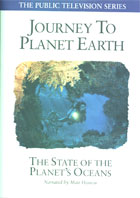
Journey to Planet Earth: The State of the Planet’s Oceans 2009
Distributed by Screenscope Inc., 4330 Yuma Street, NW, Washington, DC 20016; 202-364-0055
Produced by Screenscope, Inc. and South Carolina Educational Television
Directed by Hal Weiner
DVD, color, 55 min.
Sr. High - Adult
Environmental Studies
Date Entered: 07/15/2009
Reviewed by Jeremy Linden, Head of Archives and Special Collections, Daniel A. Reed Library, State University of New York College at Fredonia, Fredonia, NYEvery school child learns at a young age that approximately 70% of our planet is covered by water, and that only 2.5% of that water is fresh – the salt water that comprises the rest is largely held in our seas and oceans. The surface of those oceans, visible to our eyes, and separating us from the world of undersea life and ecosystems, effectively masks their contents. Observation is difficult, and events may pass unnoticed for too long. Journey to Planet Earth: The State of the Planet’s Oceans calls our attention to this part of our world, discussing not only the role our oceans play in human life, but the growing impact of our actions, both direct and indirect, on their waters and inhabitants.
State of the Planet’s Oceans follows the filmmakers through inspections of man’s interaction with the oceans throughout the world, from fishermen in the North Atlantic to coastal populations from Southeast Asia to South America, detailing not only how man directly impacts the environment, whether through over-fishing, development, or the correction of these activities, but how our indirect actions are threatening the delicate balance. They illustrate the profound effect global warming is having on the world’s oceans and the impact that those changes will have on humankind in a vicious cycle that, once reached, may be difficult to break. Freshwater melt from the world’s disappearing glaciers threatens to raise the water level, displacing human populations from low-lying coastal areas around the world. The loss of that freshwater melt likewise will rob populations of valuable freshwater for drinking and farming in parts of South America - that subsequent loss of food production will cause humans to increasingly turn to the ocean for food, dangerously stressing already depleted or threatened fish populations. The result is a conundrum that makes it seemingly difficult to assess the current situation – as we succeed in some regards, such as the creation of protected, patrolled oceanic refuges, global warming, and the possible consequences, threaten to erase those small steps forward.
The film is not what the viewer would expect from the title—it is not a case study of different oceanic ecosystems, nor is it primarily about ocean life. Rather, their examination draws the viewer to the larger issues that are threatening, and will continue to threaten the health of the world’s oceans in the future. While new films and documentaries about the continuing trend of global warming are by no means unusual, few have dealt with the problem and its particular impact on the world’s oceans as well as Journey to Planet Earth: State of the Planet’s Oceans-for this reason, the film is highly recommended. A combination of color footage, expert commentary, and interviews, the film takes viewers to different locations, and different issues, around the globe. The DVD also includes a short version of the film and educators’ guides. State of the Planet’s Oceans is part of the Journey to Planet Earth series.